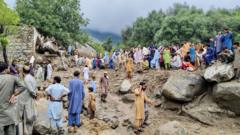Recent heavy monsoon floods have led to heartbreaking losses in Pakistan and Pakistan-administered Kashmir, claiming at least 164 lives in just 24 hours. The majority of these casualties, around 150, occurred in the mountainous region of Khyber Pakhtunkhwa. Rescue operations have been severely impacted, notably by a helicopter crash in bad weather that killed five crew members.
In addition to the fatalities in Khyber Pakhtunkhwa, at least nine people lost their lives in Pakistan-administered Kashmir, and five others in the northern Gilgit-Baltistan area. As heavy rains continue, meteorologists are warning of further rainfall until August 21, prompting the declaration of several regions as disaster zones.
In Bajaur, a region bordering Afghanistan, local residents gathered around heavy machinery digging through mud as they mourned those lost. Grief was palpable as funeral prayers commenced nearby for victims whose bodies were covered with blankets.
In Indian-administered Kashmir, rescue teams worked tirelessly to recover bodies trapped in debris after floods swept through a Himalayan village, killing around 60 people. Monsoon rains create approximately 75% of South Asia's annual precipitation, resulting in regular landslides and floods; this year alone, over 300 fatalities have been recorded.
The current monsoon season has been particularly deadly, with Punjab province experiencing a staggering 73% increase in rainfall compared to last year, resulting in more deaths than in the previous season. Environmental scientists assert that climate change is exacerbating the intensity and frequency of such extreme weather events.




















